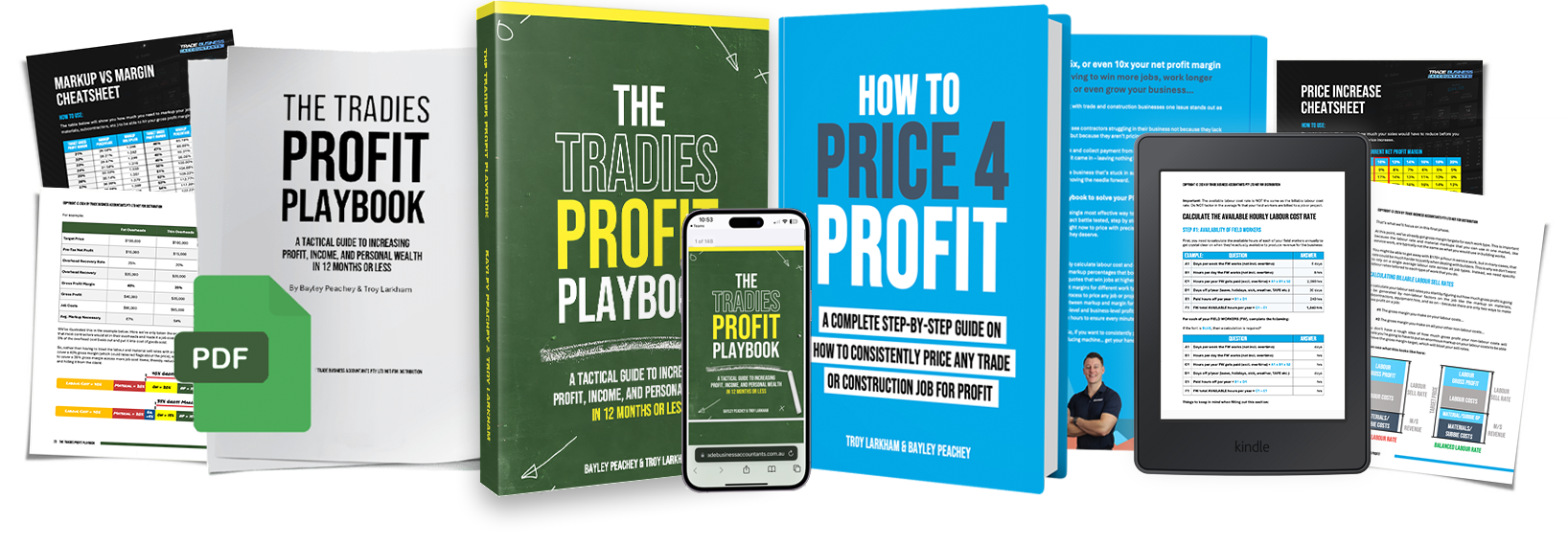Having just listened to a new client explain a lack of money despite being busy.
The answer?
“I’m not sure”
What gross margin are you quoting your jobs at? I then asked…
He didn’t know this either.
Ohhhhhh boy was I excited…
I knew straight away he’d see his bank account EXPLODE over the next 90 days.
But more on that in a moment...
Because 90% of the businesses that come to us face this same challenge.
The most common cause?
Pricing without targets.
No targets = no consistency.
Meaning some jobs you win, some jobs you lose (and lose BIG).
But what’s the best way to fix this?
Simple.
Know the ‘engine room’ of your business.
Gross profit.
Let me show you how this works…
Step #1: Set a net profit margin target
Use these guidelines to help set your target…
5% is likely a business on life support.
10% is likely an okay business.
15% is likely a good business.
20%+ is likely a great business.
Step #2: Calculate your overhead recovery rate
Now divide your overheads by your sales for the last 12 months.
For example:
FY23 overheads = $200,000
FY23 sales = $1,000,000
Overhead Recovery Rate: $200,000/$1,000,000 = 20%
Step #3: Calculate your gross profit margin target
Gross Profit Margin Target = Net Margin Target + Overhead Recovery Rate
For example:
Gross Profit Margin Target = 15% + 20% = 35%
This is the MINIMUM gross profit margin needed to cover your overheads and achieve your desired net profit margin.
AKA the engine room of your business…
Step #4: Calculate your billable labour cost rates
Now calculate the billable labour cost rates for each field worker/role.
For example:
Tradesman total cost to business (incl. super, workers comp, etc.) = $100,000
Tradesman available hours = (40 hours * 52 weeks) – holidays, sick days, TAFE days, etc. = 1,800 hours
Tradesman avg. billable rate = 70%
Tradesman billable hours = 1,800 hours x 70% = 1,260 hours
Billable Labour Cost Rate = $100,000 / 1,260 hours = $79.40 / hour
Step #5: Calculate the raw job costs
Work out the total raw cost to deliver the job (without any markups or overheads) considering:
The total labour cost from start to finish i.e. time on site, job paperwork, travel, supplier trips, clean up etc...
Material costs...
Subcontractor costs...
Equipment costs...
Step #6: Calculate the minimum quote price
The minimum quote price = Total Raw Job Cost / (1 – gross margin target)
For example:
Minimum quote price = $10,000 / (1 – 0.35) = $15,385.00
This is the MINIMUM amount you’d need to charge to:
(1) Cover the job costs
(2) Cover overheads
(3) Hit your target net profit margin (assuming the job goes to plan)
And this is the fastest and most predictable way to fill up your bank account.
So start with the end in mind.
Otherwise risk your gross profit margin being lower than it should be.
(with your bank account paying the price)
Which brings me back to our client...
He didn’t have any pre-determined targets.
Instead he just priced job to job averaging a 32% gross profit margin.
But here’s the kicker…
In his market he should have been pricing at a 50% margin!
Do $1,000,000 in sales and that’s a loss of $180,000…
i.e. MORE work for LESS money.
Sound silly? It's not.
Many owners I see should be working half as many hours for twice as much money.
Only instead they try to “hard work” their way to success.
So I encourage you to try this framework to price your work at a level that allows you to live a life outside your business.
No more late nights, stress filled days or missing out on family BBQs.
Quote so you can put down the hammer/plyers and pick up some meat tongs!
You and your family deserve it.
You don’t have to pay any money and there’s no sneaky ulterior motive…
All we ask is that you use what you learn and pass it on to a friend in need!



